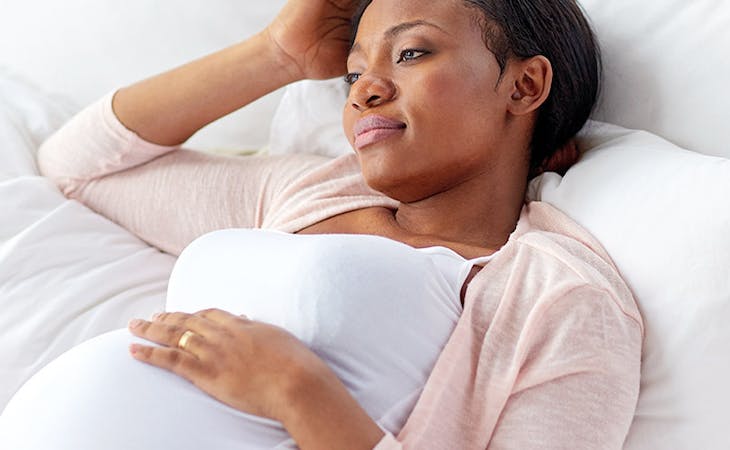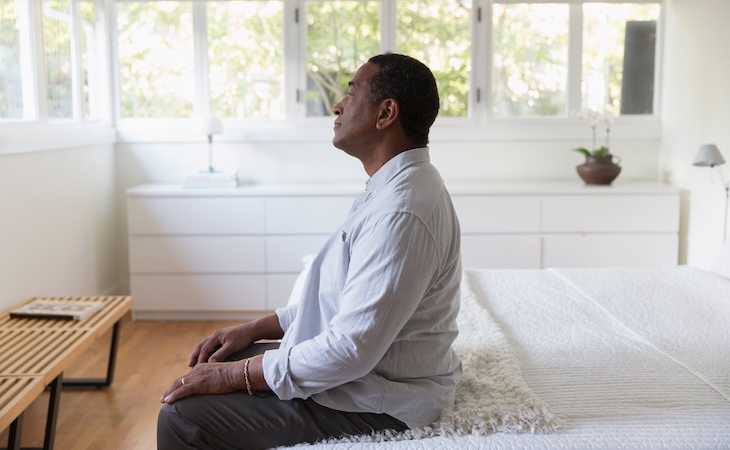On top of everything else going on during pregnancy, up to 94% of women with a baby on the way also suffer from some kind of sleep disturbance, whether that’s restless sleep, waking up too early, having a hard time falling asleep, weird dreams, or getting up five times in the middle of the night to go to the bathroom.
Pregnancy comes with a slew of hormonal and bodily changes that affect sleep quantity and quality—to say nothing of the psychological and emotional components of impending motherhood. The challenges are different at different stages of pregnancy and can impact shuteye in different ways.
Fortunately, it’s possible to sleep well throughout the nine months of pregnancy. This guide outlines the most common sleep issues in each trimester and offers a doctor’s expert tips for getting your best rest.
How to sleep well during your first trimester
The first three months of pregnancy are often characterized by one main symptom: fatigue. One day you’re running around, keeping to your regular schedule; the next day you’re a walking zombie. “This happens due to the surges of a hormone called progesterone,” explains Adeeti Gupta, MD, ob-gyn and founder of Walk In GYN Care, a New York City-based walk-in center dedicated to women’s health. While tiredness passes—women usually regain much of their energy after week 12—sleeping well during those first few months can yield benefits throughout pregnancy.
Nausea is another common first-trimester sleep stealer. If you’re suffering from morning sickness (which doesn’t always just strike in the morning), the American College of Obstetricians and Gynecologists (ACOG) notes that both vitamin B6 and doxylamine (an ingredient in pregnancy-safe OTC sleep meds such as Unisom) can help while also allowing you to get some rest.
At the beginning of a pregnancy, progesterone can also contribute to increased urinary frequency, meaning you’re getting up to go more frequently, so stay hydrated during the day but be conscious of how much you’re drinking in the hours right before bedtime.
During these early weeks, you don’t have to fret too much about exactly how you sleep, says Gupta. Even sleeping on your stomach before you’re showing is fine, she says.
Related: The best mattress for pregnancy
How to sleep well during your second trimester
When the haze of nausea and fatigue finally clear, the second trimester of pregnancy often comes as a relief to moms-to-be. “All the body functions—sleep, energy, appetite—are at their best in the second trimester,” says Gupta, “so sleep patterns are usually normal.”
Of course, during this time, you’ll likely start to feel your baby move, something that can be a bit distracting if it’s a new sensation and you’re trying to fall asleep. You could also start to suffer from heartburn or tingling legs, as both tend to come on during the second trimester. In fact, the National Sleep Foundation (NSF) notes that some 26% of women could experience restless legs syndrome (RLS) during pregnancy and that 30-50% could experience heartburn.
Keeping up with your prenatal vitamins—folate and iron—can reduce symptoms of RLS, the NSF notes. And try to eat an earlier dinner—lying down right after a big meal can exacerbate feelings of heartburn as stomach acid can more easily flow upward.
While a new study from the journal Obstetrics & Gynecology notes that any sleep position is safe for women up to week 30 of pregnancy, sleeping flat on your back may not be the most comfortable for you during your second trimester. When you sleep on your back, “there’s a risk of compressing the aorta [the main artery of the body] and the big venous vessel called inferior vena cava by the heavy uterus,” Gupta explains. That can lead to decreased blood flow to the heart and hence the entire body, including back to the uterus, and could leave you feeling dizzy or even cause you to faint.
Instead, sleep on your side with your head and upper back elevated at a 45-degree angle, she says. If you can, lie on your left side: “Sleeping on the left reduces the risk of compression on the inferior vena cava, reducing the risk of cutting blood flow back to your heart,” Gupta says. (Find out if taking melatonin during pregnancy is safe.)
How to sleep well during your third trimester
For some women, the third trimester can re-surface (and bring about additional) sleep issues. It tends to be the worst trimester in relation to sleep patterns, Gupta says.
Late pregnancy sleeplessness kicks in for various reasons: difficulty finding a comfortable position and increasing anxiety levels, just to name a few. “There are a lot of physical and hormonal changes going on in the body at that time, plus the mental apprehension of what to expect and getting oneself ready for a baby,” Gupta notes. Some women may even start having nightmares or bad dreams. (Some research suggests dream content tends to be tied to pregnancy.)
Other research finds that waking up at night is the most common sleep disturbance in the third trimester; by the end of pregnancy, almost all women wake up in the middle of the night (and stay awake for longer amounts of time too). Furthermore, a study out of the University of Granada found 64% of pregnant women experienced bouts of insomnia in their third trimester. A silver lining? That study also found that regular moderate to intense exercise during pregnancy can be protective against pregnancy-related insomnia.
Just can’t seem to get comfortable? The ACOG suggests sleeping on your side with one or two pillows between your legs or under your abdomen for support; a pregnancy pillow can help too.
Gupta also encourages stress-reduction techniques like meditation and yoga, calming non-caffeinated tea such as chamomile, a warm shower pre-bed, and reading pregnancy books. But stick to well-informed ones, she advises, not scary pregnancy or birthing stories. That way you’ll be prepared, not freaked out.
Once baby is here, we’ve got you covered with the best sleep tips for new parents and advice on how to sleep after a C-section.







